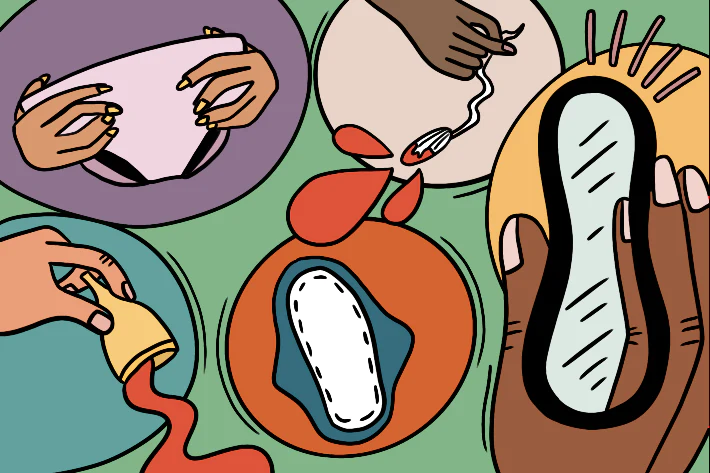My first period happened in January. I honestly don’t remember how old I was but it was my younger sister’s sledding birthday party and I went to the bathroom and legitimately thought that I had like hit the sled too hard or something.
Nope. I had become a woman.
The following years were full of awkward pads and trying my first tampon before an eighth grade talent show dance performance to JLo’s Let’s Get Loud. Then tampons did the trick for a while with a pantyliner side car (I think I had some endometriosis that I chalked up to the tampons leaking).
Then let’s fast forward through 24 years of being a little surprised when it showed up every month and then scrambling to find supplies and remember to carry supplies around with me.
After the kids were born I had an IUD. It was not that painful to have inserted and it did its job. But every four to six to twelve weeks I would have a moment of panic going “omigosh I don’t think I’ve gotten a period in a while what if I’m pregnant and the IUD is like growing into the baby’s head”.
Rational? Maybe not. But it definitely happened.
All the while I am doing research on hormone health. Human females that menstruate experience a cycle of hormones that regulate this process. There are also daily hormone cycles that regulate our digestive system, sleep and internal organ health. When any of these are out of whack we experience symptoms ranging from mood swings to needing to pee often to insomnia and hair loss.
I was noticing mood swings (and I bet my family noticed them even more than I did) and took my hormonal health efforts to the next level. I tried seed cycling but it was difficult to keep track of when my low-dose hormone IUD kept my period at bay.
The decision was made to have my IUD removed to allow my body to get back to it’s homeostasis. I expected that some hormonal imbalances would be present but I couldn’t address them while a tiny device pumped out synthetic progesterone. Also I had made the decision to switch to clean skincare and cleaning products so having this little thing going at the same time didn’t really align with my values.
I managed my first period with pads and tampons like I used to and I was upset by the amount of waste the products created. And then the Great Tampon Shortage of 2022 hit the news and I knew it was time to switch.
I ordered the SAALT Soft Cup and have used it now for several cycles and I’m honestly impressed with how well it works. Yes, there’s a bit of a learning curve but the company provides instructions and there are a lot of help articles online.
SAALT is a BCorp and they give 2% back to provide period care to regions with the most need, and help fund initiatives in menstrual health, education, and sustainability. American girls and women could use more education on their menstrual health too!
Did you know that while cramps are common they’re not “normal”?
I had terrible cramps for the first 15 years of my period. I would have to go home from work or stay home from classes and my mom fondly reminds me that I asked for a hysterectomy on more than one occasion. So add carrying Midol to the list of things I used to have to remember when my period arrived.
Menstrual cramps occur for one (or two) reasons:
- Magnesium Deficiency – our body uses magnesium for a lot of functions and we burn through it fast… even faster when we are menstruating. Try a daily supplement to help keep your stores full and add a dose during your period if you’re experiencing cramps.
- Elevated inflammatory prostaglandins – AKA increased inflammation due to
- Stress
- Processed Foods
- Alcohol*
- Gut Dysfunction*
- Toxin Exposure (pollution and products)
- Over or Under Exercising
- High BMI
- Smoking
- Infections/Viruses
*I can report that I have had virtually ZERO cramps since starting my magnesium daily supplement, switching to a plant based diet and eliminating alcohol. I by no means expect anyone else to do all three but if you experience painful cramping consider these life style changes for the few days leading up to and during your period.
Switching to a menstrual cup is the natural next step in my journey of health and wellness and sustainability. Sure it might seem like a tampon is just a few cotton balls smushed up around a string but tampons and pads can contain:
- Dioxins & furans – Linked to cancer, endocrine disruption, and reproductive toxicity. These are byproducts of the bleaching process.
- Pesticide residues – Some are linked to cancer and potential endocrine disruption. Pesticide residues have been detected in products made with traditionally grown cotton.
- Plastics & plasticizers – Linked to endocrine disruptions and cancer. Also contribute to plastic pollution due to lack of biodegradability.
- Problematic coatings – Some tampons are coated with harmful materials to help with a smoother removal. Examples of these coating substances include: paraffin (not biodegradable), polyethylene (plastic), polyethylene glycol ingredients (contamination concerns), and more.
- Undisclosed fragrance ingredients – May contain chemicals linked to cancer, endocrine disruption, and allergies. Many pads, and sometimes tampons, come in scented varieties.
Sure there were women who suffered from period cramps and endometriosis all throughout history and I’m sure there were plenty with magnesium deficiencies. It was only 100 years ago that progesterone, estrogen, and testosterone were even identified! We’re still learning.
For me, considering humans evolved to what we are today 200,000 to 300,000 years ago, I would bet the less chemical way of doing things is going to work out in the long run.

[sources & further reading: MadeSafe.org, BunsInBalance.com, HelloClue.com and TheGirlsCo.com]
- share -